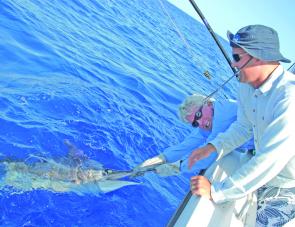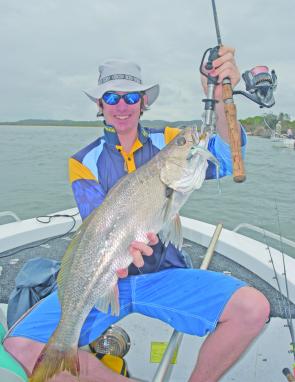June is an interesting month on the offshore grounds. The water temperature starts to drop to around 21ºC making the pelagic action slow down a bit. Despite this, some of the biggest wahoo and Spanish mackerel always turn up in this period.
If the water is blue with a bit of southbound current, targeting big wahoo is a great option on the Nine Mile this month. Small live tuna slowly trolled around the back ledges can get you some of the most explosive hits you are ever likely to encounter. Big mackerel, wahoo and the ever present bronze whalers are the usual suspects when a live tuna is demolished in a ball of froth and foam. Most of the big wahoo I’ve caught have fallen to this method, and quite a few over 30kg are happy to attack tuna up to 5kg in weight.
Trolling high speed lures such as Hex Heads is also a good method with the best speed around 12-15 knots. This gets some pretty high impact strikes as most of the fish encountered this month will be pretty big, so use the bigger lures and 15-24kg line.
Expect to catch quite a few mac tuna as well this month, although their numbers have greatly decreased this season off the Tweed. I’m not sure why this is, but they are definitely not as abundant as they used to be.
As the water cools, snapper start to move on to the inshore grounds, and the 36 fathom line should be worth a fish if the westerlies start to blow and the mornings are cold. A lot of snapper have been caught on deep soft plastics, octopus jigs and cuttlefish imitations over the past few seasons, but it is hard to beat a well-fished lightly weighted WA pilchard. Some days the jigged lures are very effective, but they can be strangely quiet on other days. A deeply fished live bait is another great method to pull some quality snapper.
On the 50 fathom line there should be plenty of pearl perch, amberjack and Samson. Remember the new bag and size limits apply to both of these species. Deep live baits, jigs and cuttlefish imitations all work very well. There should also be plenty of yellowtail kingfish around this month on the northern end of the 50 fathom line.
For anglers chasing billfish there should be a mix of both blue marlin and striped marlin on the wide grounds, with the odd black still around on the 50 fathom line and Spot X. There can be surprisingly good marlin fishing in June if the seas stay calm and the water warm. Yellowfin tuna are a potential by-catch as well.
The good late season run of striped marlin off Sydney and Port Stephens may turn up off the Gold Coast if the long liners left any still swimming.
Closer to the Seaway, the cobia should show up on the 18 fathom line east of the Seaway. Deeply fished big slimy mackerel are the most popular method but the annual cobia run is very erratic. Plenty of big fish were caught last season, so hopefully this year will be a repeat.
The large amount of rain in April should encourage plenty of baitfish schools on the inshore grounds so there should be a few predators in attendance.
As the westerlies start to blow a lot of estuary species begin their spawning run in earnest. Bream, tiger mullet, luderick and sea mullet all start to congregate around the Seaway and Jumpinpin areas and there is a lot of fish movement throughout the system, which attracts fish such as tailor and mulloway. The schools also start to move out on to the beaches as the westerlies start to blow.
The dropping water temperatures also greatly improve the flathead fishing as they start to move up on to the flats and feed actively in the months prior to spawning. Summer species such as mangrove jacks, cod and trevally tend to be less active or move out of the estuaries. Crabs are a lot harder to find.
June is a great month to fish soft plastics on light tackle in the Broadwater between Crab Island and the top of Tippler’s Passage. The main species encountered will be flathead and bream. At this time of year, most of the flathead will be around 35-50cm in length with the odd bigger fish, so in general only use 2-3kg braid, light leader and lures between 4-8cm.
It is pretty hard to keep up with all the new soft baits coming on to the market these days, but overall I find small Squidgies, Berkley Gulps and Atomics pretty reliable. My main colours are pink, white and chartreuse for dirtier water. Hook size is usually 2/0 to 4/0 at this time of year with a jighead size of 7-12g. The secret to soft plastics is all in how you move the lure, so time on the water and a lot of practice are the key ingredients to success.
Mulloway are another good soft plastic target this month. Fish the deeper sections of the estuary, work the lure with small subtle movement and concentrate your efforts on early morning tide changes. This is quite challenging fishing and it does take a while to develop confidence.
The minimum size for mulloway is now 75cm, which is a fairly reasonable fish. Use lures around 15-20cm in length, typically jerk shads or larger paddle-tails. As conditions get colder mulloway get a lot more active.
Overall, June is a good month to brave the increasing cold and get on the water for some very enjoyable fishing. As the water cools there is a phenomenal amount of fish movement in all areas, and this gives some great angling opportunities.
Reads: 4635
Grant Thompson with a striped marlin. There can be surprisingly good marlin fishing in June if the seas stay calm and the water warm.

Michael Green with a jew just under the new legal size.

The dropping water temperatures greatly improve the flathead fishing.




